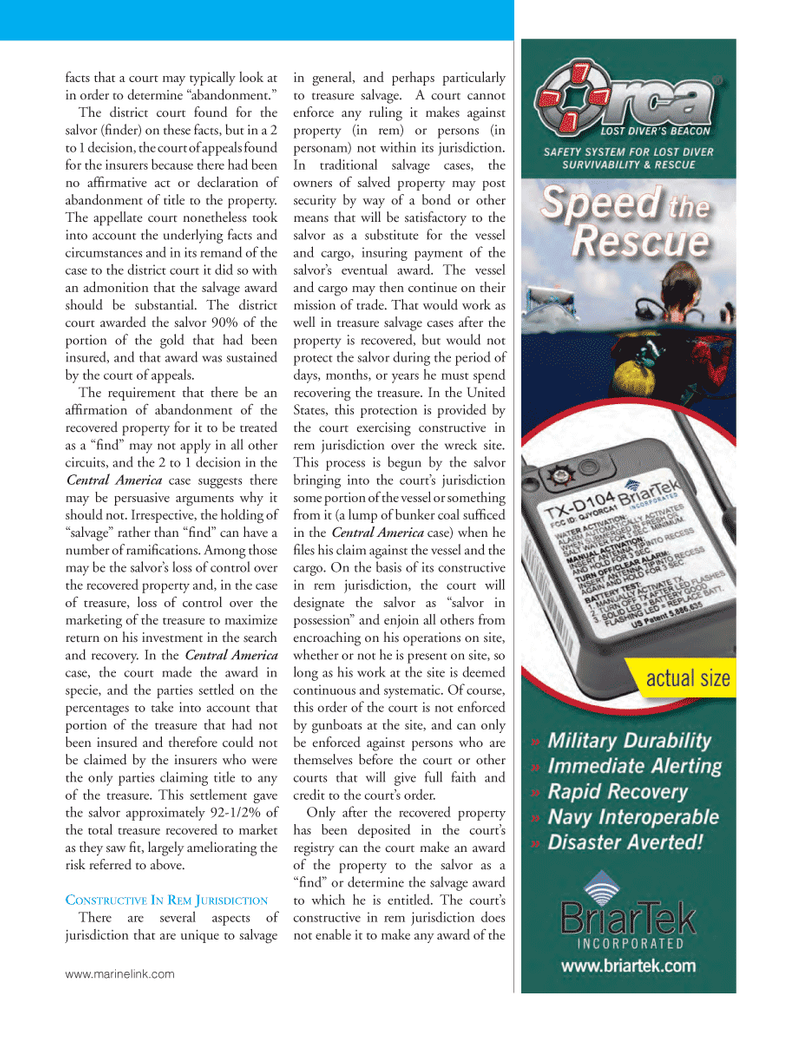
Page 23: of Marine News Magazine (August 2012)
Salvage & Recovery
Read this page in Pdf, Flash or Html5 edition of August 2012 Marine News Magazine
facts that a court may typically look at in order to determine ?abandonment.? The district court found for the salvor ( nder) on these facts, but in a 2 to 1 decision, the court of appeals found for the insurers because there had been no af rmative act or declaration of abandonment of title to the property. The appellate court nonetheless took into account the underlying facts and circumstances and in its remand of the case to the district court it did so with an admonition that the salvage award should be substantial. The district court awarded the salvor 90% of the portion of the gold that had been insured, and that award was sustained by the court of appeals. The requirement that there be an af rmation of abandonment of the recovered property for it to be treated as a ? nd? may not apply in all other circuits, and the 2 to 1 decision in the Central America case suggests there may be persuasive arguments why it should not. Irrespective, the holding of ?salvage? rather than ? nd? can have a number of rami cations. Among those may be the salvor?s loss of control over the recovered property and, in the case of treasure, loss of control over the marketing of the treasure to maximize return on his investment in the search and recovery. In the Central America case, the court made the award in specie, and the parties settled on the percentages to take into account that portion of the treasure that had not been insured and therefore could not be claimed by the insurers who were the only parties claiming title to any of the treasure. This settlement gave the salvor approximately 92-1/2% of the total treasure recovered to market as they saw t, largely ameliorating the risk referred to above. CONSTRUCTIVE IN REM JURISDICTIONThere are several aspects of jurisdiction that are unique to salvage in general, and perhaps particularly to treasure salvage. A court cannot enforce any ruling it makes against property (in rem) or persons (in personam) not within its jurisdiction. In traditional salvage cases, the owners of salved property may post security by way of a bond or other means that will be satisfactory to the salvor as a substitute for the vessel and cargo, insuring payment of the salvor?s eventual award. The vessel and cargo may then continue on their mission of trade. That would work as well in treasure salvage cases after the property is recovered, but would not protect the salvor during the period of days, months, or years he must spend recovering the treasure. In the United States, this protection is provided by the court exercising constructive in rem jurisdiction over the wreck site. This process is begun by the salvor bringing into the court?s jurisdiction some portion of the vessel or something from it (a lump of bunker coal suf ced in the Central America case) when he les his claim against the vessel and the cargo. On the basis of its constructive in rem jurisdiction, the court will designate the salvor as ?salvor in possession? and enjoin all others from encroaching on his operations on site, whether or not he is present on site, so long as his work at the site is deemed continuous and systematic. Of course, this order of the court is not enforced by gunboats at the site, and can only be enforced against persons who are themselves before the court or other courts that will give full faith and credit to the court?s order. Only after the recovered property has been deposited in the court?s registry can the court make an award of the property to the salvor as a ? nd? or determine the salvage award to which he is entitled. The court?s constructive in rem jurisdiction does not enable it to make any award of the www.marinelink.com

 22
22

 24
24
